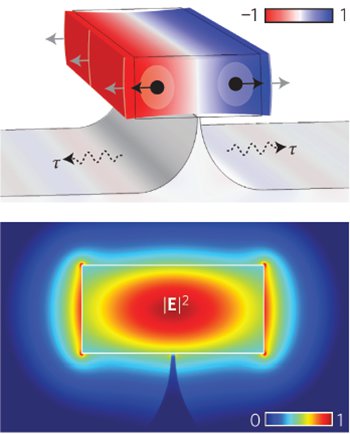 Both sound (top) and light (bottom) are trapped in a nanoscale silicon waveguide core. [R. Van Laer et al. Nat. Photon. 9, 199 (2015)]
Both sound (top) and light (bottom) are trapped in a nanoscale silicon waveguide core. [R. Van Laer et al. Nat. Photon. 9, 199 (2015)]
The century-old study of photon–phonon coupling has seen a remarkable surge of interest recently. Spurred by first observations of dynamical back-action,1 the field moved on to ground-state cooling2 and the counting of individual phonons.3 One branch looks at the potential of traveling-wave, optically broadband photon–phonon interaction in nanoscale integrated silicon circuits.4,5 A main driver of this field is that silicon waveguides can be fabricated by the same technological toolset as electronic circuitry, so their production can easily be scaled up.4,5
Optical confinement in these nanowires is based on total internal reflection: light propagates more slowly in the silicon core than in the surrounding air and oxide. Simply confining light is one thing, but manipulating it is another. This is where light–matter interaction (that is, nonlinear optics) comes into the picture: it allows some photons to control other photons via material excitations—in this case, phonons.
We recently managed to confine not only light but also sound to silicon nanowires.5 The phonons oscillate at 10 GHz, far more rapidly than human ears can hear. Researchers have realized that the sound cannot be trapped in the wire by total internal reflection, as sound, unlike light, moves faster in the silicon core than in the surrounding air and oxide.4,5 Thus, we sculpted the environment of the core to make sure that any vibrational excitation trying to escape it would actually bounce back because of acoustic-impedance mismatch. In doing so, we confined both light and sound to the same nanoscale waveguide core.
Trapped in that incredibly small area, the photons and phonons strongly influence each other: light generates sound and sound Doppler-shifts light, a feedback loop known in the nonlinearoptics community as stimulated Brillouin scattering. We exploited this interaction to amplify certain frequencies of light. We anticipate that this demonstration will open up new ways to manipulate optical information on a chip. For instance, light pulses could be converted into sonic pulses and back into light— thus implementing much-needed delay lines.
Researchers
Raphaël Van Laer, Bart Kuyken, Dries Van Thourhout and Roel Baets, Ghent University–IMEC, Belgium
References
1. T. Kippenberg et al. Phys. Rev. Lett. 95, 1 (2005).
2. J. Chan et al. Nature 478, 89 (2011).
3. J.D. Cohen et al. Nature 520, 522 (2015).
4. P. Rakich et al. Phys. Rev. X 2, 1 (2012).
5. R. Van Laer et al. Nat. Photon. 9, 199 (2015).
